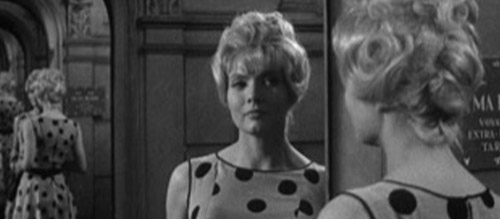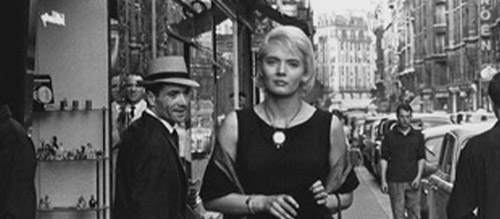Cléo from 5 to 7 (1962) Review
This article was written exclusively for The Film Magazine by Eve O’Dea of eveonfilm.com.
Cléo from 5 to 7 (1962)
Director: Agnès Varda
Screenwriter: Agnès Varda
Starring: Corinne Marchand, Antoine Bourseiller, Dominique Davray, Dorothée Blank
If a brief Google search is to be believed, it is not an exaggeration to state that Agnès Varda was the only female film director of the French New Wave, a highly influential film movement that took place from the late 1950s to mid-1960s. Some would even argue that Varda’s first feature film, La Pointe Courte (1955), was a precursor to the French New Wave in its aesthetic, dialogue, and themes. This first film draws from her background as a photographer, playing out more like a series of photographs than a motion picture. La Pointe Courte is interesting and innovative, but to some it can feel fatiguing. It is her next feature, Cléo from 5 to 7 (1962), that cements Varda as one of the greatest filmmakers, not just of the French New Wave, but of all cinema.
Cléo from 5 to 7 follows a young, beautiful, up-and-coming pop star, Cléo, as she wanders aimlessly around Paris for ninety minutes, all the while awaiting a potentially fatal diagnosis of stomach cancer. We are with her as she interacts with friends and strangers and contemplates the rivalry of her inner and outer selves.
Despite its inclusion on many French New Wave ‘best of’ and ‘essential viewing’ lists, Cléo from 5 to 7 would be more appropriately labeled as an anti-New Wave film. Varda’s work has the outer trappings of a French New Wave piece: intrusive editing that grabs the audience’s attention, Paris as a setting that combines the modern and the traditional, a refusal to stay within any single film genre, and a beautiful woman at its centre. However, there is an essential ingredient missing that was emblematic of the French New Wave: cynicism. At the time of the film’s release, France was at the tail-end of a war with Algeria that saw thousands of young men exposed to violence and cruelty. This brutality, that became so familiar to young French people, was a major contributor to the influx of delinquent lead characters in their national cinema, such as Jean-Paul Belmondo in several works of Jean-Luc Godard, or the young Jean-Pierre Léaud in François Truffaut’s The 400 Blows (1959). The films of Godard and other New Wave directors present violence nonchalantly and without consequence. Often, these films end with the unceremonious death of the main character, deaths which are so abrupt that they are almost funny. The sarcasm and pessimism that runs through these films is so strong that the audience may wonder if the filmmaker holds contempt towards them, as if criticizing them for watching the movie in the first place. Godard and Truffaut are undeniably great filmmakers, but this kind of attitude that permeates through their bodies of work can make them unapproachable and difficult to enjoy (and perhaps that’s the point).
Agnès Varda is different, her work displaying a palpable love and affection for both her characters and audience. It is very possible that Varda observed the cynicism portrayed in the films of her colleagues and consciously decided to not follow suit. In later interviews, Varda said as much:
“Nothing is banal if you film people with empathy and love,”
“Everybody is so full of mystery, so full of beauty, so full of tenderness”
“I’m intrigued by people, and I love them, to be honest”
“I don’t want to be a spy of the person I film, I want to be a friend”
Such care and affection can be felt in viewing her films, which depict subjects honestly and without judgment. Cléo, the film’s protagonist, is far from perfect. She is narcissistic, selfish, overly dramatic, and sensitive. Yet by the end of the film, one cannot help but love her. We grow to understand her anxieties and her fears, and wish that someone was there to comfort her. Cléo is played by Corinne Marchand, a statuesque blonde who lights up the screen from beginning to end. Marchand leaves each of us wondering why she did not have a career as prolific as other captivating women of the New Wave, such as Anna Karina, Brigette Bardot, Jeanne Moreau, Anouk Aimée, or Catherine Deneuve. Her perfect performance in this film as an egotistical hypochondriac burns brighter than many other actors’ entire careers.
Like other films of the New Wave, Cléo from 5 to 7 uses conspicuous editing to emphasize the uncertainty taking place within Cléo’s head and the anxiety of living in a major, bustling metropolis. Beyond the editing, the film is full of imagery that further accentuates such themes. The conflict at the film’s centre – whether or not Cléo has a life-threatening illness – is one of many allusions to the complicated relationship one has with one’s body, particularly as a woman. Cleo is constantly looking at herself in mirrors; mirrors that are broken, fragmented, and multifaceted. She is unable to see a clear reflection of herself. Just as her exterior is seemingly fractured, her interior self is unstable. When she is not looking at herself, others are looking at her. In one scene where Cléo walks down a Parisian sidewalk, passersby look directly at the camera, creating a greater feeling of unease. On other occasions, the female body is put on display at the hands of others. Cléo and her friends drink out of novelty glasses featuring nude pinups, displaying the informality with which the female body is treated. Later, Cleo visits her friend Dorothée who poses nude at an artist’s workshop, she watches her friend’s figure as it is molded and constructed by spectators. Cléo, given her insecurities and obsession with her body, is unable to conceive how Dorothée could do such a job:
“I’d feel so exposed, afraid they’d find a fault.”
“They’re looking at more than just me, a shape, an idea. Like I wasn’t there, as if I was asleep.”
While this is meant to explain the ease with which one can pose nude in front of strangers, this line further emphasizes how women and their bodies are looked at and picked apart rather than allowed to exist as whole, complicated persons. Cléo’s body is her worst enemy, something she both fears and loves. She is uncomfortable in her own skin, which is presented in her constant changing of clothes, wigs, and accessories, as well as her inability to sit down and stay in one place for more than a few seconds. It appears as if she believes that if she stops moving, she’ll stop living.
As other films of the French New Wave presented the impact the Algerian War had on young men and society at large, Cléo herself may be an allegory for the ignorant citizens of France that remained neutral and undisturbed by the war. She represents those who are unbothered by a conflict thousands of miles away, instead concerned with herself, her image, her beauty, her wellness. The final act of the film strengthens this interpretation, as Cléo is accosted by a young man in uniform, Antoine, in a park. At first, she tries to deflect his attention, but after his persistence, she realizes that he’s exactly who she needed to talk to. She is unable to ignore him, just as France is unable to ignore the destruction it has caused. By the end of the film, their fates have switched. She is cured of her worry and may return to normal, but he is still leaving for Algeria tomorrow. Once the war is over, France will be able to carry on as it did before, but these young men will still be traumatized, or dead. Antoine is intelligent, observant, and charming. We quickly understand what a waste it would be to send a mind like his to war. Like Cléo, he is afraid of an encroaching death as a casualty of war. But unlike Cléo, who is superstitious and seemingly afflicted with every sort of phobia, Antoine is optimistic and full of admiration for the world around him. Here, Varda presents her mastery of human connection. The relationship between these two is not a friendship nor is it romantic. It is a pure alliance of support and empathy, one that invites the viewers into the world of the film and asks them to stay.
Every frame of Cléo from 5 to 7 is masterful. The contents of the scene are so strategically placed that they may go unnoticed upon first viewing, and may completely change the meaning of the scene upon a second. Yet it feels effortless. Agnès Varda did not have to create magnificent sets or use fanciful cinematography. She knew that the real world was already beautiful, and knew exactly how to bring this beauty to the screen. By filming this world with love rather than contempt, Agnès Varda made Cléo from 5 to 7 a joy to revisit and a true treasure of international cinema.
24/24
Written by Eve O’Dea
You can support Eve O’Dea in the following places:
Website – eveonfilm.com
Twitter – @EveOnFilm




[…] [4] O Dea, E. (2020): Cléo from 5 to 7 Review – A True Treasure of International Cinema, The Film Magazine [online]. […]